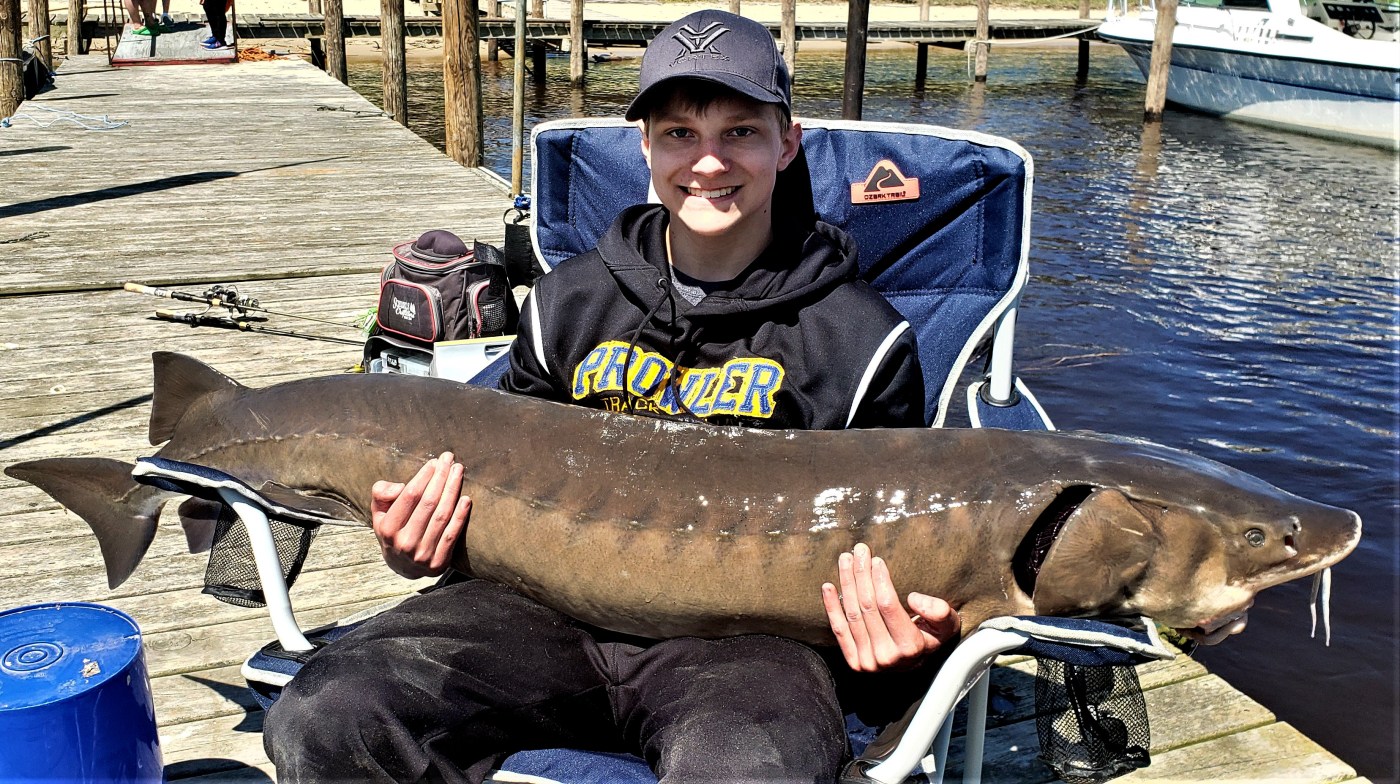
Common sense prevails in Feds’ lake sturgeon ruling
Common sense doesn’t always prevail, but it sure is nice when it does.
Such was the case Monday morning, when the U.S. Fish and Wildlife Service issued a news release saying it would not consider lake sturgeon for federal protection under the Endangered Species Act.
Lake sturgeon such as this 60-inch specimen, caught Saturday, April 17, 2021, on the Rainy River, have become relatively common on Lake of the Woods and Rainy River, along with fish even larger. (Brad Dokken / Forum News Service)
The Center for Biological Diversity had pressured the FWS to list lake sturgeon for federal protection, citing drastic population declines in parts of the species’ range over the past century.
The FWS faced a court-ordered deadline of June 30 to decide, but announced its ruling April 22.
Hats off to the agency for its ruling, a 12-month finding showing that management efforts, among them fish stocking and removal of barriers such as low-head dams to fish passage, have contributed to “the conservation and resiliency of the species.”
Nowhere, perhaps, is that more apparent than in Minnesota – and especially on Lake of the Woods and Rainy River – where lake sturgeon have met short-term recovery goals set by the Minnesota Department of Natural Resources and Ontario’s Ministry of Natural Resources and Forestry. The abundance of lake sturgeon larger than 40 inches in the Rainy River and portions of U.S. and Ontario waters of Lake of the Woods has increased from an estimated 16,910 in the late 1980s to about 92,000 in 2014.
That’s a nearly six-fold increase.
Similar success stories are playing out in the Red River Basin, where dozens upon dozens of lake sturgeon in May 2022 were observed spawning in the Upper Otter Tail River, the first documented sighting in a century of such an occurrence.
The DNR, along with the White Earth and Red Lake nations, the North Dakota Game and Fish Department and the FWS, among others, have partnered on stocking efforts in the Red River Basin for the past two decades, and the efforts are paying dividends.
Scott Gangl, fisheries management section leader for the North Dakota Game and Fish Department in Bismarck, might have said it best in a story I wrote in March, just weeks before Monday’s FWS ruling.
“As far as our perspective, it seems like (lake sturgeon) are in much better shape than they were 20 to 25 years ago, and I don’t know what could be done any better if they were listed,” Gangl said.
He’s right.
In more than two decades of writing about the outdoors, the recovery of lake sturgeon in our part of the world ranks among the most rewarding issues I’ve covered.
Time was, it was a big deal when someone caught a 50-inch sturgeon on the Rainy River, for example. These days, it takes a sturgeon pushing 70 inches or more to warrant mention.
I hadn’t even started my first cup of coffee Monday morning when the news release came out, and it was fun to hear the reaction from Kevin Hinrichs – aka “The Dutchman” – of Baudette, Minnesota. Hinrichs and his wife, Jenn, purchased Royal Dutchman Resort on the Rainy River in 2020 amidst the uncertainty of the pandemic, and sturgeon anglers are a major part of their client base.
A ban on sturgeon fishing, had the FWS ruled that Endangered Species status was necessary, wouldn’t have been beyond the realm of possibility. Ontario doesn’t allow sturgeon fishing on its portion of Lake of the Woods and Rainy River, even though the species is recovering well.
The reason for that ban, as I reported in 2012, results from Ontario’s Endangered Species Act, which classifies lake sturgeon in three broad geographical regions. Lake sturgeon may be doing well in Lake of the Woods and Rainy River, but that’s not the case elsewhere in northwestern Ontario, the region in which the fishery falls.
Anglers haven’t been able to fish sturgeon on the Ontario side of Lake of the Woods and the Rainy River – just yards across the river from the Hinrichs’ resort – since 2009.
A similar ban would have been devastating to their business, Kevin Hinrichs said. The fear of such a ban, and the months of uncertainty that preceded Monday’s ruling, made for some tense times, he admits.
Hinrichs aggressively worked to spread the word on social media about the potential listing and the impact it would have, and lawmakers, including U.S. Rep. Pete Stauber, R-Minn., and Sen. Amy Klobuchar, D-Minn., both weighed in urging the FWS to side with science.
“I was holding my breath because in this world that we live in right now, nothing is set in stone and nothing is guaranteed,” Hinrichs said. “It seems like we’re going one direction one second and another the next.”
Now that the uncertainty is past, it’s time to focus on sturgeon fishing; springtime is prime time.
“It’s a big booster for our economy this time of year,” Hinrichs said. “I couldn’t be more happy with the outcome.”
Chalk one up for common sense.
Related Articles
MPCA will monitor a year’s worth of Mississippi River water within the state
North Shore streams, and their steelhead trout, are running
Are big changes coming to the Boundary Waters?
Want to catch and release big fish with minimal harm? DNR has tips.
Minnesota DNR is rewriting its statewide muskie plan


